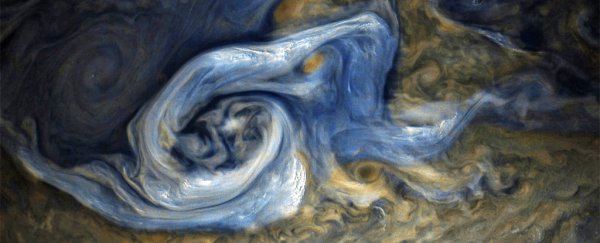The Juno probe has been delivering some epic science since it launched in 2011, and this time it's delivered a glimpse into Jupiter's mysterious depths - and its weird gravitational field.
Three studies, published today in the journal Nature, have probed Jupiter's gravitational field to reveal exactly how dynamic Jupiter's atmosphere is; how deep it extends; and what's inside Jupiter when the atmosphere ends.
In the first paper, led by Luciano Iess of the Sapienza University of Rome in Italy, a team of researchers used the Doppler, or redshift, data of Juno as it orbits around Jupiter. This directly correlates to Juno's velocity - which, in turn, is affected by Jupiter's gravity.
The team's analysis was assisted by a high precision transponder that measures Juno's velocity down to 0.01mm/s accuracy, even while travelling at record speed orbits of 70 km/s.
As planetary scientist Jonathan Fortney of the University of California Santa Cruz put it in an accompanying editorial, this was "no mean feat," since the team had to account for every tiny acceleration Juno underwent, including those not caused by Jupiter's gravity.
We already knew that Jupiter's gravitational field is asymmetrical for some reason. Iess's team studied all components of the field, both symmetric and asymmetric.
Because Juno is in polar orbit, it can examine both poles separately, which is what the team did - and they found that part of Jupiter's gravitational field does not have north-south symmetry.
Since the majority of the field is symmetrical, caused by the planet's fast rotation, the team discovered that Jupiter's internal flows were causing the asymmetry.
"Winds on Earth are caused by pressure gradients between areas of lows and highs. Lows and highs are associated to different atmospheric densities. The same mechanism is at play at Jupiter," Iess told ScienceAlert.
"Winds are associated to density variations in the atmosphere. In turn, density variations have a gravitational signature. By measuring the magnitude of the gravity due to the winds, one has information about their depth."
This link was explored further by a team led by Yohai Kaspi of the Weizmann Institute of Science in Israel, which studied the asymmetry of Jupiter's magnetic field to determine the depth of its atmosphere.
They determined that the magnitude of the winds of Jupiter decayed with altitude, finally petering out at a depth of around 3,000 kilometres (1,864 miles) below cloud level.
In all, Jupiter's atmosphere constitutes about 1 percent of the planet's total mass - but the finding opens the door to learning a lot more about how Jupiter works.
"Galileo viewed the stripes on Jupiter more than 400 years ago. Until now we only had a superficial understanding of them, and have been able to relate these stripes to cloud features along Jupiter's jets, Kaspi told ScienceAlert.
"Now, following the Juno gravity measurements, we know how deep these extend and what is their structure beneath the cloud-level. It's like going from a 2D picture to a 3D one" he told ScienceAlert.
"In addition, the gravity signature of the jets is entangled with the gravity signal of [Jupiter's] interior. Now that we know the gravity signature of the atmosphere, it will help us in better understanding the interior structure, core mass and eventually the origin of Jupiter."
But what if we went even deeper than those 3,000 kilometres below cloud level? That's where the team led by Tristan Guillot of the University of Côte d'Azur comes in.
His team confirmed the depth measurement, but then found that at greater depths, Jupiter's deep interior is a fluid mixture of hydrogen and helium, liquefied by the intense pressure inside the planet, rotating as a solid body.
"It is an almost 50-year old puzzle in planetary science that is solved," Guillot told ScienceAlert.
"We didn't know whether a gaseous planet like Jupiter (but also Saturn, Uranus, Neptune and giant exoplanets) rotates with zones and belts all the way to the centre or whether on the contrary the atmospheric patterns are skin-deep.
"Now, thanks to Juno's amazing accuracy (it measured Jupiter's gravity field 100 times better than before), we have the ground truth."
The new discoveries demonstrate that very precise measurements of a planet's gravitational field can reveal complex and detailed information about its interior - which is a giant leap in our understanding about the gas giant.
It also points towards the next areas to study. Iess's team is set to study the Jovian tides raised by Io and other moons. Kaspi hopes to take more measurements of the Great Red Spot using similar methods. And Guillot will be working on a detailed analysis of the planet's interior composition, and the mass of its central core.
"The work demonstrated here is extremely robust," Fortney wrote in his editorial. "I do not foresee another leap in knowledge on Jupiter's interior after the Juno mission ends, unless astronomers are able to study the planet's internal oscillations, as has been done for the Sun."
The three papers can be found in Nature here, here, and here, and you can find the editorial here.
